I still remember standing in a muddy shipping yard, trying to figure out why a fully loaded container couldn’t be moved. Turns out, we had the wrong chassis type for the job. Expensive mistake.
That moment made one thing clear, not all container chassis are built the same.
If you’ve ever dealt with late deliveries or costly rework, you’ll get it. I’ve worked closely with companies across construction and industrial sectors to break down the different chassis types—and where they fit best.
In this article, you’ll find:
- The 8 most common types of container chassis used in the industry
- Key features, benefits, and ideal use cases for each type
- Practical tips to help you choose the right one for your business
Let’s dive in!
Quick Comparison Chart
Before investing in container chassis, it’s essential to understand how each type performs across critical operational features. This detailed comparison helps you weigh strengths and suitability based on your specific business needs.
| Chassis Type | Container Compatibility | High-Cube Support | Adjustable Lengths | Hazmat or Chemical Transport | Custom/Industry-Specific Options |
| Standard Container Chassis | Supports standard 20-ft and 40-ft ISO containers | Not suitable for high-cube containers | Fixed length; no adjustment | Not designed for hazardous cargo | Not customizable; best for basic general freight |
| Extendable Chassis | Accommodates 20-ft, 40-ft, and 45-ft containers | Supports high-cube containers | Length adjustable for multiple container sizes | Not typically configured for hazmat use | Limited customization; optimized for flexibility |
| Gooseneck Chassis | Built for high-cube 40-ft and 45-ft containers | Specifically designed for high-cube clearance | Fixed length; purpose-built for high-cube support | Not suitable for chemical or liquid transport | Limited customization options |
| Drop Frame Chassis | Designed for high-cube, reefer, or bulky cargo | Excellent support for high-cube and reefer | Fixed frame; no sliding or extension | Not typically used for hazardous materials | Some customization options for reefer or agri freight |
| Tri-Axle Chassis | Handles standard ISO containers | Supports high-cube containers | Fixed length | Not specialized for hazmat transport | Designed for weight capacity; limited beyond that |
| Tank Container Chassis | Supports only ISO tank containers | Not designed for high-cube dry containers | Fixed for tank length; not adjustable | Built for hazardous or chemical material transport | Limited to liquid or gas tank applications |
| Flatbed Chassis (Combo Use) | Fits standard containers and general flat cargo | Can support high-cube loads with tie-downs | Some models adjustable; depends on build | Not certified for hazmat but usable for mixed loads | Custom tie-downs and stake pockets for unique loads |
| Specialty Chassis | Custom-built for specific container or load types | Fully adaptable to high-cube requirements | Can include adjustable, extendable, or hybrid designs | Can be configured for hazmat, reefer, or hybrid use | Fully customizable based on industry needs |
This side-by-side comparison gives you a clear picture of how each chassis performs across real-world applications. Whether you’re looking for flexibility, weight handling, or regulatory compliance, there’s a chassis built for it.
1. Standard Container Chassis
The Standard Container Chassis is the workhorse of the container transport world. It’s a fixed-frame trailer specifically built to carry ISO containers on roads, ports, and intermodal yards.
If you’re hauling standard-sized freight containers and your routes are predictable, this is likely your go-to setup.
Common Sizes Supported:
- 20-foot containers
- 40-foot containers
- Some models can handle 45-foot with modifications
Key Features
Let’s keep it real, this chassis type isn’t flashy, but it gets the job done. Here are six core features that matter:
- Fixed-length steel frame
- Twist-lock mechanisms
- Basic tandem axle design
- DOT-compliant lighting and brakes
- Spring or air suspension
- Tractor compatibility
Use Cases
Standard chassis are perfect for businesses that move general freight on regular routes. If you’re in:
- Logistics and 3PL services
- Port-to-warehouse transport
- Retail and consumer goods distribution
- Manufacturing-to-distribution operations
I’ve seen entire retail chains run just fine with a fleet of standard chassis. One client ran cross-state deliveries from port to store distribution centers and never needed anything else.
Benefits of Using Standard Chassis
Let’s talk about why this option still dominates the yard:
- Cost-Effective: Scale up your fleet without breaking the bank
- Low Maintenance: Fewer moving parts means fewer headaches
- Widely Available: Easy to find, easy to replace
- Great for General Freight: If it fits, it ships, no extras needed
- Driver-Friendly: Straightforward to hook up and go
- Intermodal Ready: Built for smooth transitions between rail, road, and port
Limitations
Now, here’s where you need to be careful:
- No Flexibility: Fixed frame means no sliding or extending
- Not For Heavy Cargo: Exceeds weight limits? You’ll need a stronger build
- Basic Use Only: Doesn’t support specialized cargo like tankers or reefers
- Limited on Terrain: Better suited for smooth highways than job sites or backroads
I once had a client in the food distribution space who used standard chassis for years. But when they expanded into bulk refrigerated loads, the limitations hit hard. They had to quickly upgrade their fleet to drop frames and goosenecks to stay compliant and on schedule.
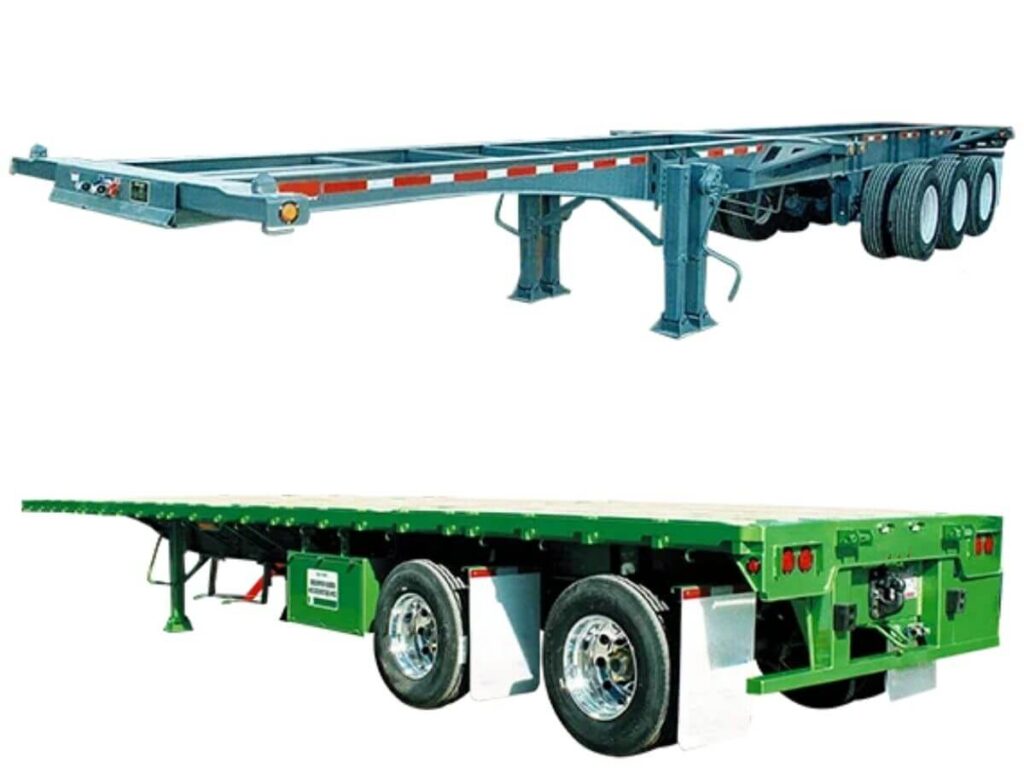
2. Extendable Chassis (Slider Chassis)
An Extendable Chassis, also called a Slider Chassis, is a versatile trailer that can adjust its length to accommodate different container sizes.
If your operations involve handling both 20-foot and 40-foot containers, or switching frequently between them, this chassis type can save you serious time and hassle.
Common Sizes Supported:
- 20-foot containers
- 40-foot containers
- 45-foot containers (select models)
Key Features
You need gear that works as hard as you do—this chassis adapts fast and performs in real-world conditions:
- Sliding frame mechanism
- Locking pin system
- Heavy-duty steel construction
- Multi-position twist locks
- Air ride or spring suspension
- Legal compliance for multiple states
Use Cases
Extendable chassis are built for fast-paced, container-switching environments. If you’re regularly loading and unloading containers of different lengths, this is your smart solution.
You’ll see these used by:
- Intermodal transport providers
- Drayage and short-haul operators
- Freight forwarders and depots
- Retail distribution hubs with variable imports
A transportation client of mine once told me this was the “Swiss army knife” of their fleet. They didn’t have to guess which chassis to send out anymore, it worked for nearly every container.
Benefits of Using Extendable Chassis
If flexibility is a core need in your business, here’s why this chassis earns its place:
- One chassis, multiple uses
- Improves asset utilization
- Reduces repositioning costs
- Boosts operational efficiency
- Minimizes driver delays
- Supports compliance
Limitations
While flexible, it’s not the perfect fit for every situation. Watch out for these potential drawbacks:
- More Moving Parts: Means higher maintenance compared to standard chassis
- Heavier tare Weight: May reduce payload capacity slightly
- Requires Driver Training: To properly extend, lock, and inspect the frame
- May Not Support Overweight Loads: Especially in more basic models
One client learned the hard way when their team used it for overweight steel coil containers. It flexed under pressure, literally. They quickly upgraded to tri-axles for that route.
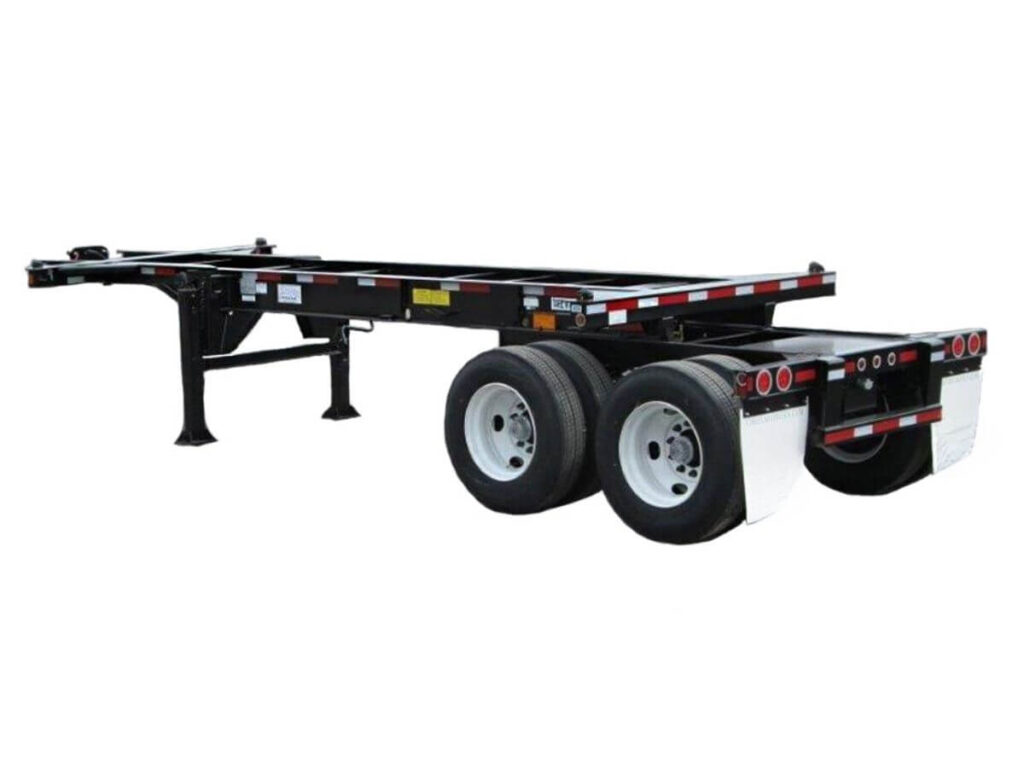
3. Gooseneck Chassis
A Gooseneck Chassis features a lowered front section, known as the gooseneck, that allows high-cube containers to sit lower to the ground.
This clever design helps meet height clearance limits without sacrificing container space, especially for 9’6″ tall containers.
Common Sizes Supported:
- 20-foot high-cube containers
- 40-foot high-cube containers
- 45-foot containers (depending on model)
Key Features
This chassis type is built for taller loads and serious road performance. If your cargo needs more room up top, this is your fix:
- Lowered Gooseneck Frame: Allows taller containers to ride lower
- High-Cube Container Support: Prevents over-height violations
- Heavy-Duty Steel Construction: Built to handle heavy intermodal wear
- Standard Twist-Lock System: Keeps containers secure during transport
- Tandem or Tri-Axle Options: Available for different load requirements
- DOT Height Compliance: Helps meet bridge clearance laws in multiple states
Use Cases
If you’re in an industry moving tall, space-consuming containers, this chassis pays off quickly. It’s especially critical in operations where high-cube freight is standard.
Common users include:
- Import/Export Companies Hauling High-Cube Cargo
- Retailers Moving Overseas Shipments With Volume Packaging
- Agriculture and Food Distributors With Pallet-Stacked Containers
- Construction or Mining Sectors Using Oversized Container Units
- Manufacturers Needing Extra Interior Height During Transport
Benefits of Using Gooseneck Chassis
This isn’t just a design upgrade, it’s a strategic advantage for the right operation:
- Maximizes Vertical Container Space: Perfect for high-cube containers
- Reduces Risk of Height Violations: Keeps you compliant on bridges and overpasses
- Improves Center of Gravity: Better balance and safer handling
- Great for Intermodal Transport: Easily transitions between ship, rail, and road
- Optional Axle Configurations: Scale up to tri-axles if needed
- Trusted by Large-Scale Operations: Built for tough and tall container work
Limitations
As with all equipment, this chassis has trade-offs. Be aware of:
- Higher Upfront Cost: More specialized design = more investment
- Limited Versatility: Not ideal for standard-height containers only
- Slightly Heavier: The gooseneck frame adds extra steel and weight
- Not Built for Non-Containerized Cargo: Strictly for container hauling
I’ve seen companies try to use goosenecks for general flat loads, but it’s not made for that. One logistics company quickly pivoted to flatbeds for flexibility, keeping their goosenecks strictly for overseas retail and port hauls.
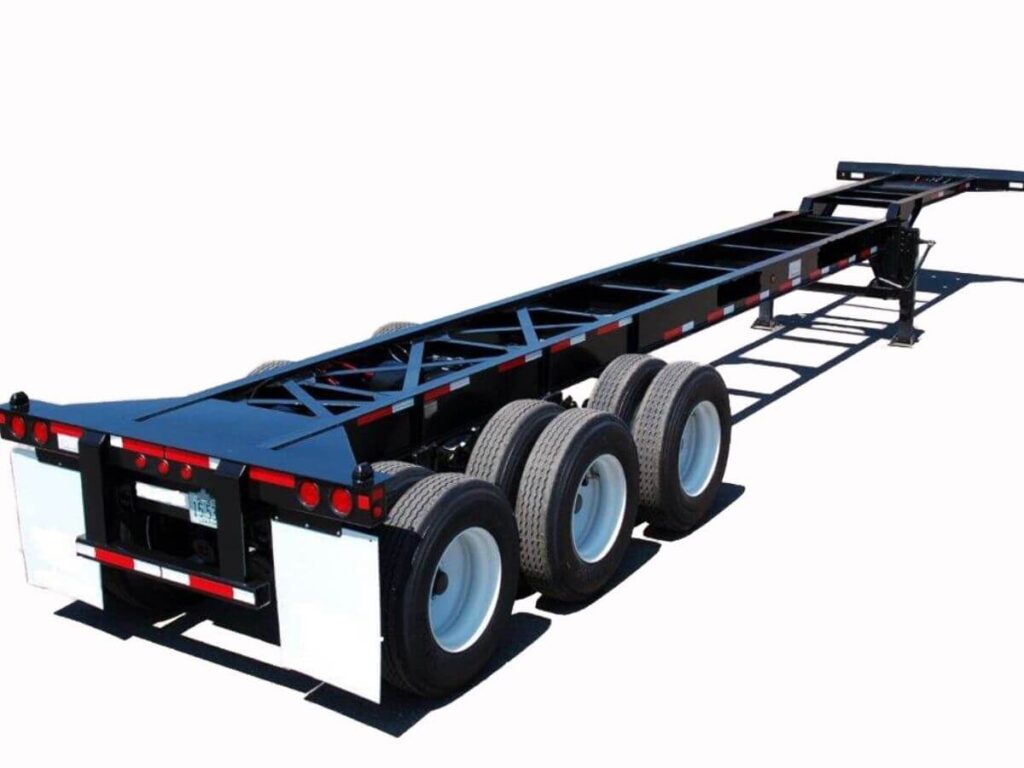
4. Drop Frame Chassis
A drop-frame chassis, also known as a drop-deck chassis, features a lowered mid-section that sits below the standard chassis height. This design allows extra vertical clearance for tall or bulky containers, making it ideal when you need every inch of space to stay compliant or protect sensitive cargo.
Common Sizes Supported:
- 40-foot high-cube containers
- 45-foot containers
- Specialized container sizes (with custom deck options)
Key Features
This chassis type is made for industries that move big, tall, or specialized loads. If you’re tired of height restrictions or load shifting, this will change the game:
- Lowered Mid-Deck Frame: Provides additional vertical clearance
- High-Cube Container Compatibility: Easily handles 9’6″ containers
- Strong Steel Construction: Built for heavy-duty and uneven loads
- Twist-Lock Securement: Keeps containers locked into place during transit
- Air Ride Suspension Option: Ideal for fragile or sensitive freight
- DOT Compliance: Meets legal height limits even with taller cargo
Use Cases
Drop frame chassis shines in industries where height, weight, and balance are non-negotiable.
If your loads sit tall, ride fragile, or need precise handling, this is the solution.
Common users include:
- Refrigerated and Perishable Goods Transporters
- Food and Agriculture Shipping Operations
- Energy and Utility Equipment Haulers
- Mining and Industrial Suppliers With Oversized Units
- Manufacturers With Custom Container Builds
One of our long-time partners in the ag industry said switching to drop frames was like “getting breathing room back.” No more scraping height limits or worrying about overpasses.
Benefits of Using Drop Frame Chassis
This isn’t just about extra inches, it’s about solving serious transport challenges:
- Increased Vertical Clearance: Accommodates taller containers without issues
- Ideal for Refrigerated Containers: Drop deck reduces overall stacked height
- Better Load Balance: Lower center of gravity improves road safety
- Excellent for Specialized Cargo: Supports tanks, generators, and complex units
- Protects Sensitive Freight: Smooth ride with air ride options
- Compliance Friendly: Reduces over-height violations and delays
Limitations
There’s always a trade-off with specialized gear. Keep these points in mind:
- Higher Cost: More complex frame = more investment upfront
- Limited Container Versatility: Not made for short or non-high-cube containers
- Heavier Tare Weight: Slightly lowers your net payload
- Less Common in Rental Fleets: May require custom ordering or lead time
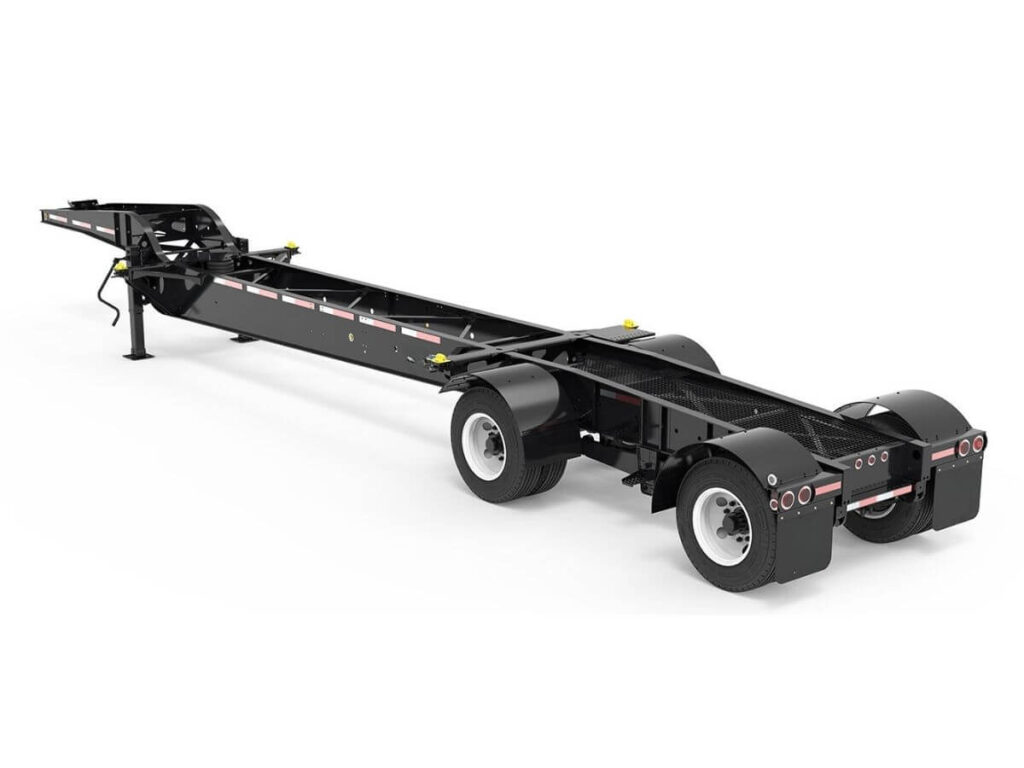
5. Tri-Axle Chassis
A Tri-Axle Chassis is a heavy-duty container trailer designed with three axles instead of the usual two. This added axle gives you higher weight capacity, better balance, and the ability to legally haul heavier container loads without violating road regulations.
Common Sizes Supported:
- 20-foot containers
- 40-foot containers
- High-cube and overweight containers
Key Features
When your business moves the heavy stuff, this chassis holds its ground, literally. It’s rugged, stable, and built to take the pressure:
- Three-Axle Configuration: Distributes container weight more evenly
- Increased Payload Capacity: Handles heavier containers legally
- Reinforced Frame Design: Built for mining, construction, and industrial use
- Enhanced Braking System: Better stopping power under heavy loads
- Air or Spring Suspension: Optional setups for better ride control
- DOT Bridge Law Compliance: Legal across more jurisdictions
Use Cases
If your loads are heavy, oversized, or your routes have strict axle weight limits, this chassis earns its keep every mile. Common users include:
- Mining and Construction Companies Moving Bulk Materials
- Energy and Infrastructure Projects With Oversized Loads
- Industrial Manufacturers Hauling Equipment or Dense Cargo
- Ports and Rail Yards Handling High-Volume, Heavy Imports
- Agricultural Freight Needing High-Capacity Hauling
One of our clients in the oil and gas sector told me the tri-axle was the “only chassis that didn’t flinch” when hauling full-capacity tank containers on rough terrain.
Benefits of Using Tri-Axle Chassis
This chassis was made for serious weight. Here’s what it brings to the table:
- Legal Load Flexibility: Stay compliant while moving more cargo
- Built for Heavy Freight: Handles the toughest containers
- Increased Durability: Designed for high-stress environments
- Stability Under Load: Three axles = less sway and better control
- Reduces Fines and Citations: Stay under axle limits, even on strict routes
- Better ROI on Long-Haul Jobs: Fewer trips needed for heavy freight
Limitations
Tri-axles aren’t for every operation, especially if you’re dealing with lighter or more flexible freight.
- Heavier Tare Weight: Less net cargo capacity if the load doesn’t require it
- Higher Purchase and Maintenance Cost: More axles = more components
- Lower Maneuverability: Larger turning radius in tight spaces
- Not Ideal for Light or Mixed Loads: Overkill unless weight is a regular issue

6. Tank Container Chassis
A Tank Container Chassis is specifically engineered to haul ISO tank containers, used for transporting liquids, gases, chemicals, and food-grade products.
This isn’t a standard flatbed with some extra locks, it’s built for safety, stability, and regulatory compliance when your cargo can’t afford mistakes.
Common Sizes Supported:
- 20-foot tank containers (most common)
- 23-foot and 25-foot ISO tanks (specialized models)
- Some configurations support larger custom tanks
Key Features
Transporting liquids isn’t just about strength, it’s about control, safety, and precision. This chassis brings all of that:
- Tank-Specific Frame Design: Cradles cylindrical tanks for secure positioning
- Custom Twist-Lock Locations: Optimized to lock down shorter-length ISO tanks
- Reinforced Crossmembers: Added frame strength for heavy liquid loads
- Corrosion-Resistant Finishes: Protects against chemical or weather exposure
- Optional Safety Rails and Platforms: For top-access loading or inspection
- DOT and Hazmat Compliance: Designed to meet transport regulations for hazardous materials
Use Cases
Tank chassis are critical for industries moving sensitive or hazardous fluids. Precision isn’t optional—it’s mandatory. Common users include:
- Chemical and Industrial Companies Transporting Hazardous Materials
- Oil and Gas Sector Moving Fuel or Lubricants
- Food and Beverage Distributors Shipping Bulk Liquids
- Pharmaceuticals and Bio-Based Manufacturing
- Waste Management and Environmental Services
We worked with a client in the petrochemical industry who told us, “There’s no second chance when hauling what we haul.” They rely exclusively on dedicated tank chassis to meet strict federal and internal standards.
Benefits of Using Tank Container Chassis
Tank chassis do more than carry liquid, they protect your product, your drivers, and your business reputation:
- Designed for ISO Tank Compatibility: No guesswork, just fit and go
- Enhanced Safety Features: Built-in options to meet hazmat transport needs
- Secure and Stable Transport: Reduces movement and liquid shift on the road
- Minimizes Risk of Spills or Damage: Vital for chemical or food-grade hauls
- Corrosion-Resistant Build: Withstands weather, leaks, and harsh cleaning chemicals
- Regulatory-Ready: Helps you stay compliant and avoid fines or shutdowns
Limitations
This chassis is highly specialized, great when needed, but not versatile:
- Single-Use Design: Only supports cylindrical ISO tank containers
- Higher Investment Cost: A Specialized build means higher upfront pricing
- Requires Skilled Handling: Improper loading or inspection = high risk
- Not Ideal for Dry or General Freight: Can’t be repurposed for standard containers
One client once tried to use a tank chassis for a 20′ dry container during a shortage, let’s just say it didn’t end well. Fit issues, wasted time, and ultimately a second dispatch to fix it.
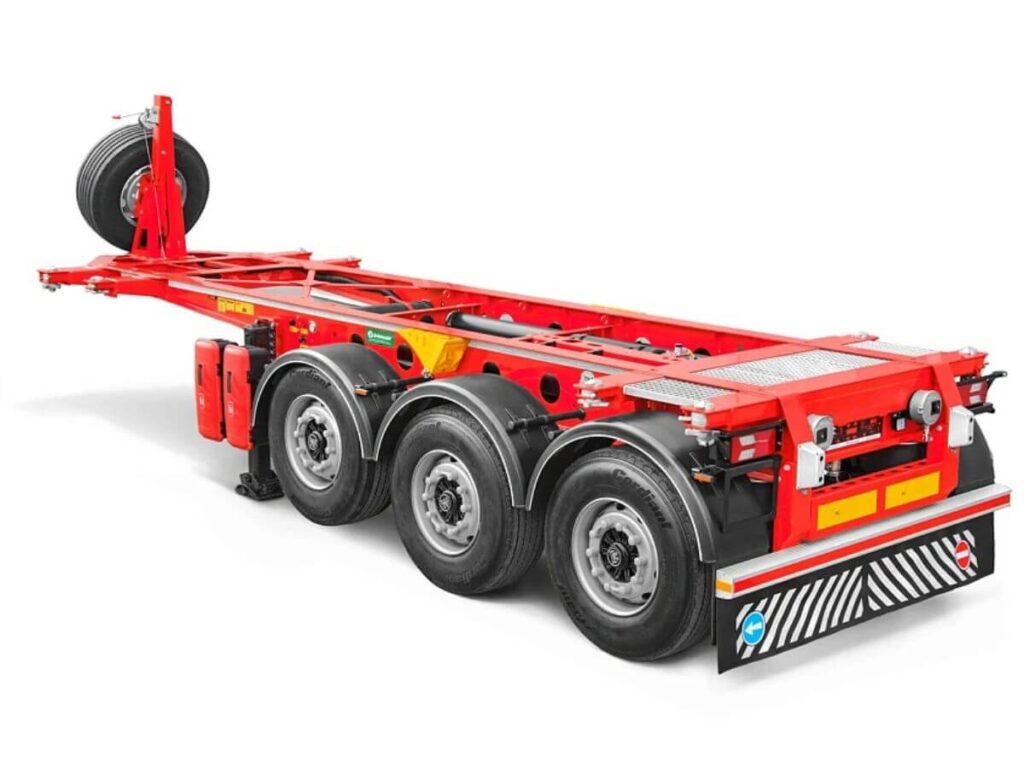
7. Flatbed Chassis (Combo Use)
A Flatbed Chassis, also known as a Combo Chassis, is a dual-purpose trailer that functions as both a container chassis and a flatbed trailer.
It’s built for operations that need to carry containers one day and oversized, irregular, or palletized cargo the next. Versatility is its biggest strength.
Common Sizes Supported:
- 20-foot containers
- 40-foot containers
- Palletized or breakbulk cargo up to standard flatbed length (typically 40–45 feet)
Key Features
This is the Swiss Army knife of chassis. When you need flexibility without switching trailers, this is what you hook up:
- Flat, Open Deck Design: Hauls containers or general freight with ease
- Integrated Twist Locks: Allows secure transport of ISO containers
- Heavy-Duty Steel or Aluminum Frame: Built for both strength and weight savings
- Stake Pockets and Tie-Down Points: Secure irregular or oversized cargo
- Air or Spring Suspension Options: Adapts to different road and load types
- Forklift Loadable: Enables ground-level loading of cargo when not containerized
Use Cases
Flatbed chassis are great for businesses that haul a mix of cargo types or run operations where equipment efficiency is a priority. Common users include:
- Construction Firms Hauling Equipment and Containers
- Agricultural Suppliers Transporting Mixed Freight
- Retail Distributors with High Seasonal Volume
- Energy Companies Moving Oversized Units
- Warehouses Handling Palletized and Container Freight
One construction firm I worked with used combo chassis to haul materials one way and containers on the return trip. It doubled their fleet efficiency without adding trailers.
Benefits of Using Flatbed Chassis
When you want adaptability without sacrificing performance, this chassis delivers:
- Multi-Use Flexibility: One trailer does multiple jobs
- Reduces Fleet Size: Fewer trailers needed to handle mixed loads
- Cost-Effective Investment: Stretch your dollar across container and flat freight
- Easier Backhauling: Increases your chances of finding return loads
- Quick Load/Unload: Forklift-ready and simple tie-down systems
- Good for Remote Sites: Works where container-only chassis fall short
Limitations
Versatility comes with trade-offs. It’s important to understand what this chassis is, and isn’t:
- Not Optimized for Containers Alone: May lack the snug fit and support of dedicated container chassis
- Heavier Tare Weight: Can lower net cargo weight due to reinforced design
- Fewer Container-Specific Features: No gooseneck, no drop frame options
- Increased Driver Attention Needed: Proper tie-down and load checks are a must with general freight
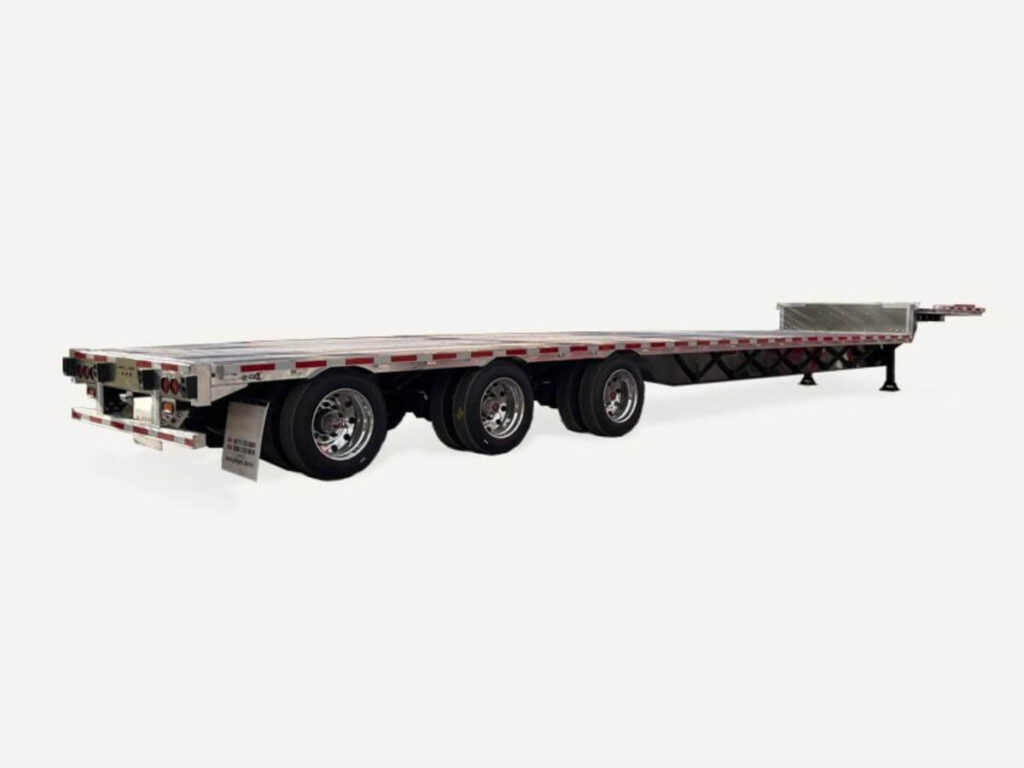
8. Specialty Chassis (Custom or Niche Use)
Specialty Chassis are custom-built or highly specific trailers designed for unique cargo, industry regulations, or performance requirements. These aren’t off-the-shelf solutions, they’re purpose-built to solve very specific transport problems that standard chassis can’t handle.
Common Sizes Supported:
- Custom configurations for 20-foot, 40-foot, or oversized containers
- Tankers, reefers, bulk containers, genset-mounted units, and more
- Some may handle non-ISO containers or intermodal hybrid units
Key Features
This chassis isn’t one-size-fits-all, it’s one-size-fits-your-business. If you’ve got a niche need, this is how it’s solved:
- Tailored Frame Design: Custom deck height, axle placement, or container fit
- Reefer or Genset Integration: Designed for refrigerated or powered container units
- Heavy-Duty Reinforcements: Built for extreme loads or off-road performance
- Specialized Locking and Mounting Systems: Supports unique cargo configurations
- Modular Features: Some can be adapted for multiple use cases
- Regulatory Compliance Engineering: Built to meet highly specific DOT, hazmat, or international standards
Use Cases
If you’ve ever said, “None of the usual options will work,” you’re in specialty chassis territory. Common users include:
- Cold Chain and Reefer Logistics Companies
- Bulk Liquid or Grain Haulers With Non-Standard Tanks
- Military or Defense Contractors Requiring Armored Units
- Energy Sector Firms With Generator or Modular Power Units
- Disaster Relief or Remote Access Teams Hauling Hybrid Cargo
One client we worked with needed a generator-mounted chassis that could support both a reefer unit and a fuel tank. Off-the-shelf just didn’t cut it, so we built them a custom solution that still runs strong today.
Benefits of Using Specialty Chassis
When the standard doesn’t fit your mission, specialty steps up. Here’s what it brings:
- Purpose-Built Performance: Designed to solve your specific transport problem
- Operational Efficiency: Reduces downtime and workarounds
- Increased Safety and Compliance: Built for specialized cargo and regulatory needs
- Unique Load Compatibility: Handles what other chassis simply can’t
- Long-Term ROI: Engineered to reduce wear, failure, and replacement cycles
- Competitive Advantage: Enables operations that other carriers can’t offer
Limitations
Custom isn’t always convenient. Make sure you consider these before investing:
- Higher Cost: Custom design and materials come at a premium
- Longer Lead Time: Built-to-order units require time to spec and manufacture
- Limited Flexibility: Often not usable outside the intended application
- Specialized Maintenance: May require trained techs or parts not widely available
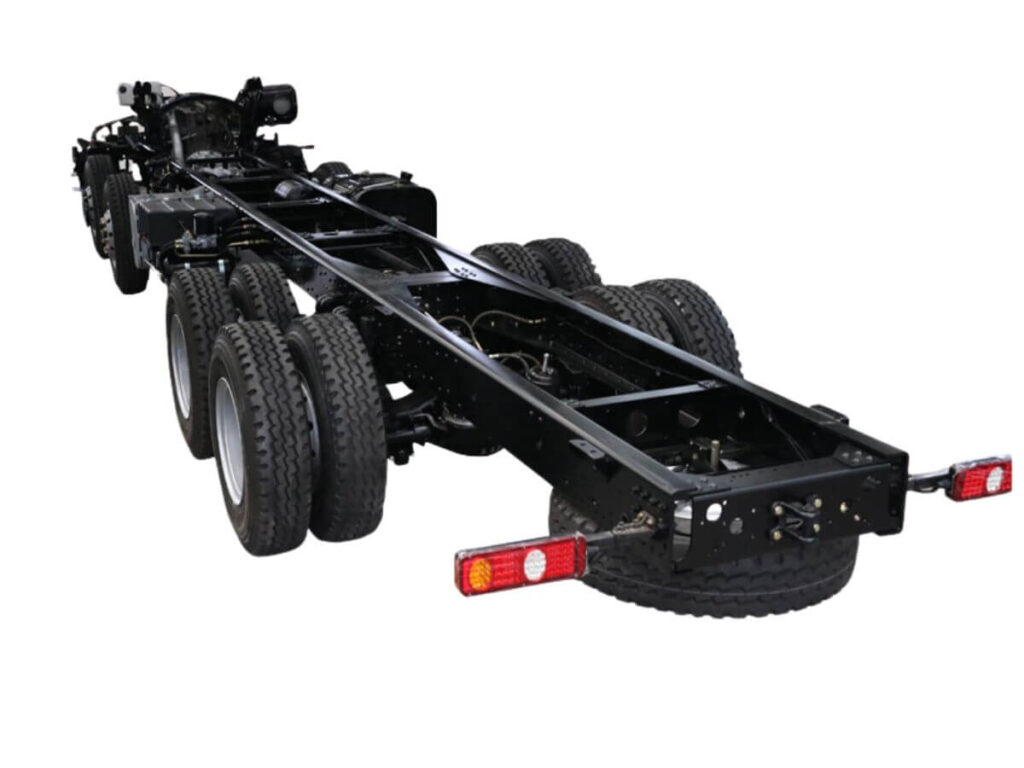
Conclusion
We’ve covered the 8 container chassis types, what they’re built for, and who they serve best. You know what works, what doesn’t, and how to choose.
I learned the hard way that mismatched equipment can shut down an entire job. Now you don’t have to.
You’re not here to guess. You’re here to grow. And the right chassis can be your edge.
Which one fits your operation best?
Contact us today and let’s get your fleet ready for what’s next.


